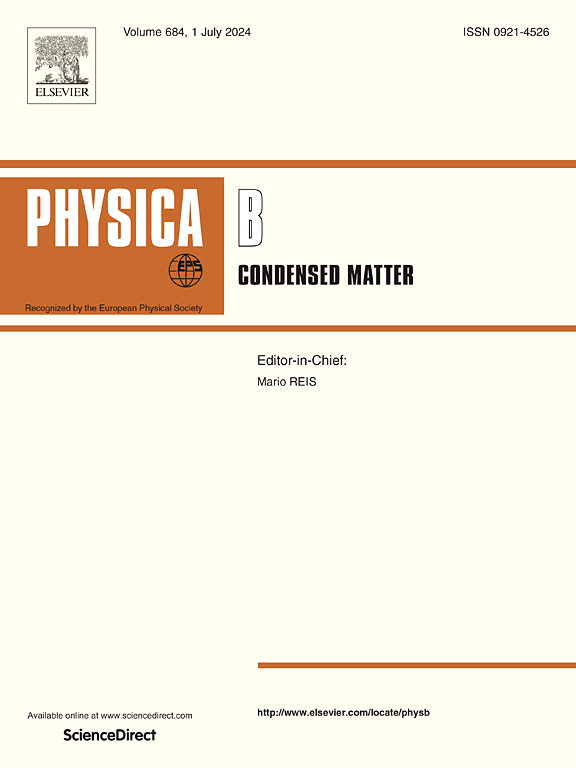伪无序尺寸分布对砷化镓纳米线阵列光电性能的影响
IF 2.8
3区 物理与天体物理
Q2 PHYSICS, CONDENSED MATTER
引用次数: 0
摘要
我们研究了由不同直径和长度的纳米晶组成的砷化镓纳米线阵列的光学和电学性质。每个单元电池中几何尺寸的混合是为了优化光吸收,从而改善这些光伏电池的电性能参数。模拟系统是一个多层结构,由透明的氧化铟锡(ITO)层、嵌入填充介质PMMA的GaAs NWs阵列的活性区和硅(Si)衬底定义。采用传递矩阵法(TMM)模拟了多层吸光度;将填充介质包围的砷化镓纳米线视为均匀层,其有效介电函数用Bruggeman有效介质理论描述。我们观察到一个典型的振荡行为,在吸光度光谱,无论类型的几何尺寸的研究。上述数值结果与文献中实验研究和在III-V型半导体纳米线中进行的复杂时域有限差分模拟的结果很好地一致,这表明当需要多层均匀化时,我们的TMM模拟足以近似考虑多层结构的光学特性。对于所研究的所有尺寸,我们得到吸光度值随着波长的增加而减小。纳米波直径越大,纳米波长度越长,阵列的光吸收效果越好。这一特性有利于提高这些光伏电池的短路密度、开路电压、填充系数和效率。在斜入射p极化下,构成GaAs NWs阵列的单元胞的直径无序程度略微改善了它们的光学和电输运性质。本文章由计算机程序翻译,如有差异,请以英文原文为准。
Effects of pseudo-disordered sizes distributions on the optical and electrical properties of GaAs nanowires arrays
We investigate the optical and electrical properties of GaAs nanowires (NWs) arrays constituted by unit cells with several NWs diameter and length sizes. The mix of geometrical sizes in each unit cell is to optimize the light absorption and the consequent improvement of the electrical performance parameters of these photovoltaic cells. The simulated system is a multilayer structure defined by a transparent layer of Indium Tin Oxide (ITO), the active region of GaAs NWs arrays embedded into the filling medium PMMA and a substrate of Silicon (Si). The multilayer absorbance is simulated by Transfer Matrix Method (TMM); while the GaAs nanowires surrounded by filling medium is treated as an homogeneous layer whose effective dielectric function is described by Bruggeman effective medium theory. We observe a typical oscillating behavior in the absorbance spectra, regardless the type of geometrical sizes investigated. The above numerical results are in good agreement with those reported in the literature by experimental research and sophisticated FDTD simulations in III–V semiconductor nanowires, which demonstrates that our TMM simulations are adequate approximations to account on optical properties in multilayered structures when homogenization of multilayers is required. For all investigated sizes, we obtain that the absorbance values decrease for longer wavelength. Greater NWs diameter and longer NWs length in the unit cells entail a better light absorption of the arrays. This feature favor an enhancement of the short circuit density, the open circuit voltage, the fill factor and the efficiency of these photovoltaic cells. With p-polarization at oblique incidence, the degree of diameter-disorder in unit cells that constitute the GaAs NWs array slightly improve their optical and electrical transport properties.
求助全文
通过发布文献求助,成功后即可免费获取论文全文。
去求助
来源期刊

Physica B-condensed Matter
物理-物理:凝聚态物理
CiteScore
4.90
自引率
7.10%
发文量
703
审稿时长
44 days
期刊介绍:
Physica B: Condensed Matter comprises all condensed matter and material physics that involve theoretical, computational and experimental work.
Papers should contain further developments and a proper discussion on the physics of experimental or theoretical results in one of the following areas:
-Magnetism
-Materials physics
-Nanostructures and nanomaterials
-Optics and optical materials
-Quantum materials
-Semiconductors
-Strongly correlated systems
-Superconductivity
-Surfaces and interfaces
 求助内容:
求助内容: 应助结果提醒方式:
应助结果提醒方式:


